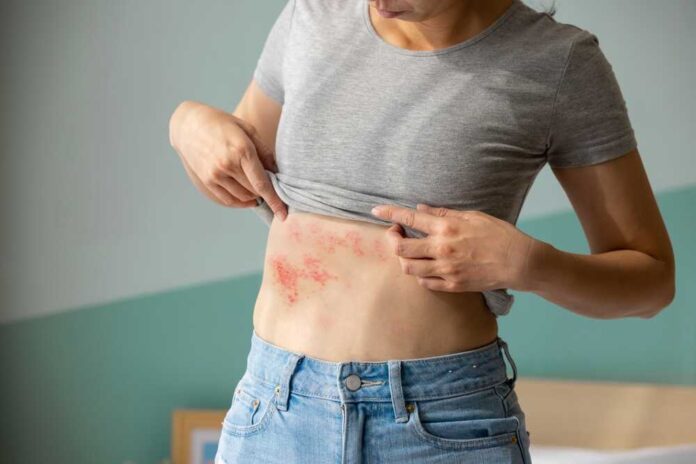
Shingles is a painful rash caused by the same virus that causes chickenpox. After having chickenpox, the varicella-zoster virus lies dormant in your nerves. Years later, it can reactivate as shingles.
The shingles rash usually appears as fluid-filled blisters on just one side of your body, often as a band around your torso or forehead. The rash can be incredibly painful, with a burning, tingling, or deep aching sensation.
If you suspect you are developing a shingles rash (or any kind of unexplained rash), consult with your doctor or dermatologist as soon as possible to ensure prompt treatment and to minimize your risk of experiencing any complications.
Keep the Rash Clean and Dry
Gently wash the rash with mild, fragrance-free soap and water. Be sure to thoroughly — but delicately — dry the area by patting gently with a clean towel. Keeping the rash clean and dry reduces risk of infection.
Apply Cool, Wet Compresses
Soak a clean washcloth in cool water and lightly apply it to blisters for soothing relief from burning, itching, and pain. Be extra careful not to break open the blisters. Avoid scratching the rash, which can spread infection and cause scarring.
Wear Loose, Soft Clothing
Tight clothes can irritate and inflame the rash. Choose loose, breathable fabrics like cotton. Direct skin contact with heavy or scratchy clothing should be minimized, so also avoid heavy fabrics like wool.
Take Colloidal Oatmeal Baths
Bathing in or applying creams with colloidal oatmeal can relieve itching and calm inflamed skin. The natural antioxidant and anti-inflammatory properties make oatmeal ideal for sensitive skin conditions. It also serves as a prebiotic, supporting the growth of good bacteria that’ll help the healing process.
Try Calamine Lotion
This inexpensive over-the-counter lotion contains zinc oxide, which relieves itching. It also helps dry oozing blisters and creates a protective barrier to prevent infection.
Ask About Antiviral Medications
Oral medications like valacyclovir or famciclovir can reduce severity and duration of a shingles outbreak. Antivirals are typically most effective when started within 72 hours of the rash appearing.
Consider Pain Medications
For significant pain relief during an acute shingles outbreak, oral medications like acetaminophen, ibuprofen, or lidocaine patches may be helpful. Topical numbing creams can temporarily relieve pain. Talk to your primary doctor before taking or applying anything to make sure it is safe for you in your current condition.
Moisturize Once Blisters Scab Over
As your blisters begin healing and scabbing over, apply a gentle, fragrance-free moisturizer. This prevents skin cracking and can quicken your healing. Ointments like petroleum jelly are ideal for very dry scabs.
Caring diligently for your skin provides comfort, prevents complications like infection, and can even speed up the healing process. See your doctor at the first sign of a shingles outbreak for proper diagnosis and treatment.
With the right skin care regimen, you can minimize symptoms and avoid skin scarring.






















